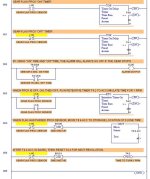CJones
Member
Not looking for the answer but pointed in the right direction.
I have one sensor wired to one input, as a large gear turns the sensor restes a timer which keeps an alarm off
If the timer runs out and the sensor has not seen it's "flag" it turns on a yellow light alarm
All is good
I want to use this same input to record RPM or in this case to scale and record the "HZ" that the drive is running.
I have tried a timer and RTO using the opposite intruction to move the number (in seconds)to a N:7 address, the only problem is it tends to reset before the move takes place?
For example if there was 15 seconds on the timer between flags I would like to move this 15 seconds and scale it out between 0 and 60 HZ.
Any takers
thanks in advance Clint
I'm using a 504 and we have to keep it simple I don't yet know how to bit shift unless you want to explain it
I have one sensor wired to one input, as a large gear turns the sensor restes a timer which keeps an alarm off
If the timer runs out and the sensor has not seen it's "flag" it turns on a yellow light alarm
All is good
I want to use this same input to record RPM or in this case to scale and record the "HZ" that the drive is running.
I have tried a timer and RTO using the opposite intruction to move the number (in seconds)to a N:7 address, the only problem is it tends to reset before the move takes place?
For example if there was 15 seconds on the timer between flags I would like to move this 15 seconds and scale it out between 0 and 60 HZ.
Any takers
thanks in advance Clint
I'm using a 504 and we have to keep it simple I don't yet know how to bit shift unless you want to explain it
Last edited:




